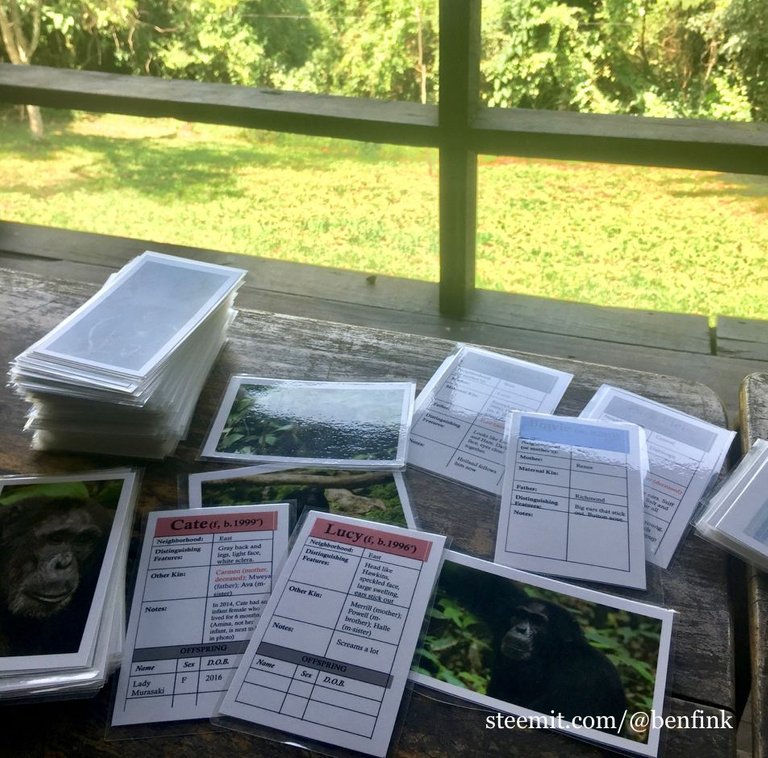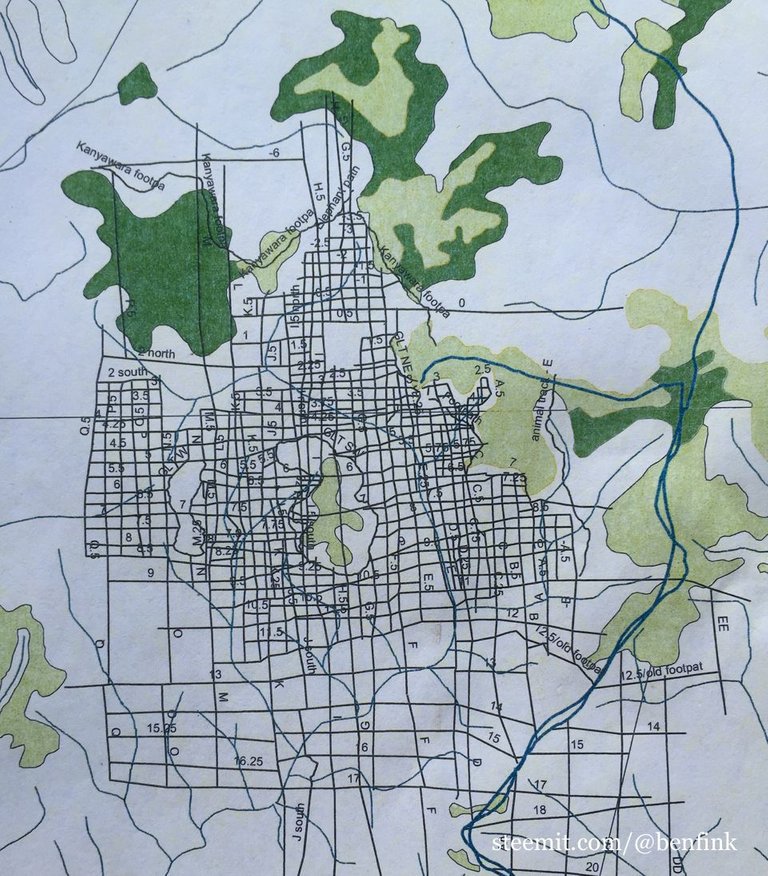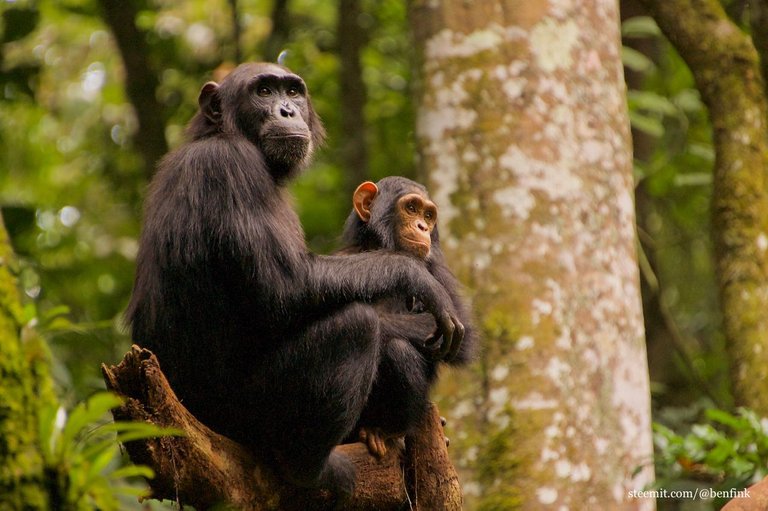Greetings from Kibale National Park, Uganda! I’m a researcher studying the lives of chimpanzees (my introduceyourself). Specifically, I follow the Ngogo chimps, a huge community of about 200 individuals that scientists have studied for over 22 years. I am here working on my doctorate, beginning a new study on foraging strategies and aging.
Celebrity selfie: researcher stops for pic with Ngogo alpha, Jackson. The face mask is to keep the chimps safe from our diseases!
Posting from the forest, I want to share with steemit the complex lives of these intelligent animals, how chimp science works, and the daily adventure (and sometimes boredom) of fieldwork. I’ll post when the internet connection and the chimpanzees’ schedule allows it.
Like I mentioned, Ngogo is big. It’s community of individuals who each have their own personality and relationships. Chimpanzees, like most primates, are social and will often spend their days around others. However, a chimp community is never all in the same place, you won’t see all 200 chimps at once. Individuals can choose to form these sub-groups, known as parties, with potential mates, friends, relatives or others. Together they travel, forage, and groom, but these parties are temporary. They form and reform all the time.
A party of the westerners. Researchers learn to ID chimpanzees from face, fur color, posture, associations, and more
As a researcher, you must be able to identify all the chimpanzees. Knowing them as individuals is the only way to understand their social lives, all the feuds and friendships, or consistently follow a chimp of interest. Just like humans, chimpanzee faces are distinct. Still, it takes time and patience to learn them all. This is my second time at Ngogo and I am still meeting new individuals nearly every day. Folks here say it often takes about two months to be comfortable with IDing.
Reveal spoiler
 Chimpanzee flashcards, collect ‘em all
Chimpanzee flashcards, collect ‘em all
Researchers must also learn the forest. The Ngogo territory stretches over roughly six square kilometers, which can be tricky to navigate. If you can’t find the chimps quickly in the morning when they are noisy, your day might go to waste. Meanwhile, keep an eye out for other wildlife. On my first day back and in the darkness of early morning, an elephant ran across the trail in front of us, trumpeting in surprise (ours too). We realized we were surrounded, approaching elephants crashing through vegetation on all sides. The only solution was to silently wait for them to pass, crouched between a tree’s giant buttresses. After that kind of a morning, it can feel relaxing to just be around the chimps.
Reveal spoiler
 The Ngogo trail system helps us find and follow the chimpanzees as well as keep track of their location
The Ngogo trail system helps us find and follow the chimpanzees as well as keep track of their location
I’ll do my best to answer questions from Steemit while in the field. Internet and time is limited, but I plan to make more post and updates on my work.
Follow for more chimpy sciencey goodness @benfink.
100% of my steem wallet goes directly to chimpanzee research and conservation
Learn more about and consider donating to support the study and conservation of the Ngogo Chimpanzees
ngogochimpanzeeproject.org | facebook

Great stuff brother! Eager to learn more about the chimp flashcards. Be safe out there.
What an awsome life you have. You are very blessed!🕉
This is super cool. Ive always wanted to go and just be a wall flower with stuff like this lol. Do you ever get nervous following them around? Have you ineracted with them?
hey @justsailey, thanks for the enthusiasm! I don't get nervous following them because they are very shy and avoid us. We've habituated them to our presence, where we get to watch closely, but we are careful to say at least 7m away to keep them safe from our diseases. We don't interact with them, because any small interaction can lead to them wanting to interact more. Right now, they treat us like suspicious trees, which is a great thing for science and their well-being.
Oh wow! Thanks for replying. Thats so cool!
Best of luck for your doctorate!
thanks @axon
Stay close to those trees when the elephants pass by! Looking forward to more of these posts. Will you be sharing stories of individual chimps? Will we get to read about what they eat? How they forage and hunt?
hey @oldfangle, I'll do my best! 🐘
Absolutely. I study food, so these will certainly be my topics. I'm already working on a post about hunting and meat eating in chimpanzees. In three days, I've seen them eat five monkeys! I hadn't thought about doing individual chimp stories/posts, but it would be a good idea to give a better idea of what they are really like. I'm open to ideas if there are things you and others find interesting. Thanks!
I'm curious as to how we perceive chimps as individuals versus their own understanding of self. (What DO they think of themselves - and how can we know that? Are we able to detach ourselves sufficiently from our cultural assumptions and biases to really study them with clear minds? Or is our perception irrevocably tainted by the everything we've seen and heard, from zoos to circuses to Disney. Looking forward to reading more from the deepest depths of Uganda!
Great questions. Our understanding of chimpanzee's internal lives, or that of any animal, is limited. But, how they behave still gives us a window. For example, if a low ranking male chimpanzee waits until everyone else leaves before copulating (something I observed today), a reasonable explanation is that he has some understanding of other's minds. He knew that if other male's saw him with the estrus female, he may get beat up This is a pretty simple action, but actually takes a lot of cognitive process, grasping others' knowledge and intent.
Observing wild animals is one thing, but most of the breakthroughs in understanding the extent of thought in non-humans comes from cognitive experiments. Carefully controlling the settings of captive animals lets us rule out alternative and simpler explanations for their behavior. There are plenty of good examples on youtube if you search "chimpanzee theory of mind experiment." This can be done in the wild as well with things called playback studies.
I really recommend the book Baboon Metaphysics for fuller answers to your questions. Our biases will never leave us, but we can follow methods carefully that allow us to remove our biases from our findings.
Wow. Interesting and useful response. Thank you! I read this as I watch a new show, "Amazing Monkeys" on the Smithsonian channel. Great images , editing and narration, but I'm thinking it can't compare with the reality of field observation.